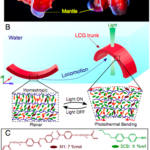Paper, Bioinspired underwater locomotion of light-driven liquid crystal gels
Soft-bodied aquatic invertebrates, such as sea slugs and snails, are capable of diverse locomotion modes under water. Recapitulation of such multimodal aquatic locomotion in small-scale soft robots is challenging, due to difficulties in precise spatiotemporal control of deformations and inefficient underwater actuation of existing stimuli-responsive materials. Solving this challenge and devising efficient untethered manipulation of soft stimuli-responsive materials in the aquatic environment would significantly broaden their application potential in biomedical devices. We mimic locomotion modes common to sea invertebrates using monolithic liquid crystal gels (LCGs) with inherent light responsiveness and molecular anisotropy. We elicit diverse underwater locomotion modes, such as crawling, walking, jumping, and swimming, by local deformations induced by selective spatiotemporal light illumination. Our results underpin the pivotal role of the physicomechanical properties of LCGs in the realization of diverse modes of light-driven robotic underwater locomotion. We envisage that our results will introduce a toolbox for designing efficient untethered soft robots for fluidic environments.
Learn about our two Decals!
 Click here to find out more about our Fall Bioinspired Design Decal and our Spring Bioinspired Design in Action Decal – ALL MAJORS are welcome.
Click here to find out more about our Fall Bioinspired Design Decal and our Spring Bioinspired Design in Action Decal – ALL MAJORS are welcome.Berkeley BioDesign Community
 Click here to learn about the BioD: Bio-Inspired Design @ Berkeley student organization or here to signup for more info.
Click here to learn about the BioD: Bio-Inspired Design @ Berkeley student organization or here to signup for more info.Search
Student Login




I imagine that the neurological circuits underlying these processes are governed by both 2d spacing maps with their brains as…
to reduce the impact of car accidents, it may be possible to study the force diverting physics of cockroaches to…
you see this type of head-bobbing stability in many avian creatures related to pigeons like chickens. the head ability to…
not like they taught horses how to run! this is an example of convergent evolution where both sea creatures and…
The brain functions in a similar way with neuronal connections. our brains are able to utilize the multiplicity of connections…